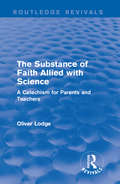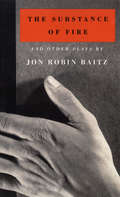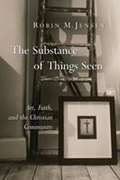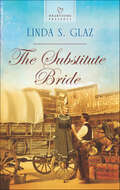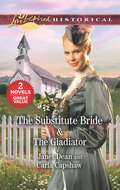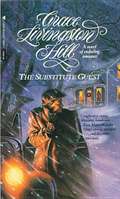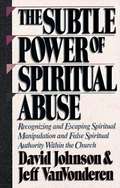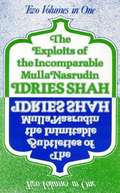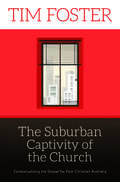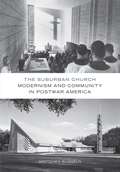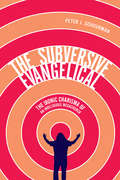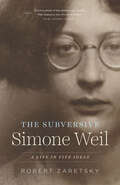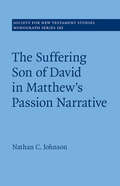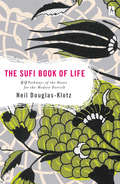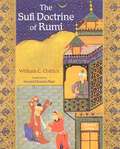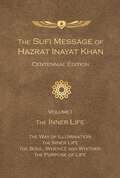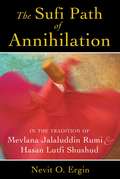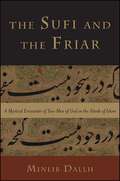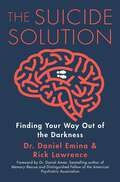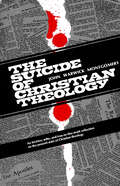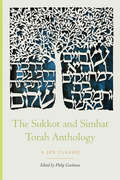- Table View
- List View
The Substance of Faith Allied with Science: A Catechism for Parents and Teachers (Routledge Revivals)
by Oliver LodgeOriginally published in 1907, this book provides information to parents and teachers wishing to teach their children about Christianity as well as science. Lodge details his fear of mandatory secularism in schools and advises how to instruct children in science without allowing any doubt of Christian doctrine and stresses the importance of reconciliation between religion and science for future generations. This title will be of interest to students of Education and Religion.
The Substance of Fire and Other Plays
by Jon Robin BaitzA frank examination of the controlling forces behind a nearly bankrupt private school for boys in South Africa, The Film Society introduced a young playwright with an extraordinarily mature grasp of people, language and society.Baitz's recent works have fulfilled his early promise and enhanced his reputation. <P><P>In The Substance of Fire (1991), a fiercely intellectual New York publisher struggles with his children for control of his business, and with the relentless pride which has made him previous to love. In The End of the Day (1992), an expatriate British doctor adapts to America by abandoning his ideals and succumbing to the twin lures of status and crime.About the Author: Jon Robin Baitz is the author of Three Hotels, The Film Society, Other Desert Cities, The End of the Day, and The Substance of Fire, which he adapted into a major motion picture. He was the showrunner on ABC's Brothers & Sisters. He also wrote the screenplay for the upcoming film Stonewall directed by Roland Emmerich. He lives in New York.
The Substance of Things Seen: Art, Faith, and the Christian Community (Calvin Institute of Christian Worship Liturgical Studies)
by Robin JensenWhile the average person rarely sees it, the visual arts play a subtle yet profound role in the teaching and formation of faith, both for individuals and religious communities. The Substance of Things Seen explores the intersection of art and faith, offering thoughtful reflections on the way art functions in Christian life and practice. <p><p> Highly readable and featuring instructive illustrations, this book is meant to engage church leaders as well as artists in constructive conversation about the critical role that art can play in the renewal of Christian education, worship, and study. It also challenges anyone who thinks the arts are only of marginal importance to the religious life. Robin Jensen considers here a broad range of topics relevant to Christian faith and culture, including the construction of sacred space, the use of art in worship and spiritual formation, the way that visual art interprets sacred texts, and the power and danger of art from a historical and contemporary perspective.
The Substitute Bride
by Janet DeanFleeing an arranged marriage, debutante Elizabeth Manning exchanges places with a mail-order bride bound for New Harmony, Iowa. Life on the frontier can't be worse than forced wedlock to pay her father's gambling debts. But Ted Logan's rustic lifestyle and rambunctious children prove to be more of a challenge than Elizabeth expects. She doesn't know how to be a mother or a wife. She doesn't even know how to tell Ted the truth about her past—especially as her feelings for him grow. Little does she know, Ted's hiding secrets of his own, and when their pasts collide, there's more than one heart at stake.
The Substitute Bride
by Linda S. GlazJared Callahan's mysterious bride Rancher Jared Callahan eagerly awaited the arrival of his mail-order bride. But instead of the kindhearted woman who wrote about escaping her constrained city life, the beauty who arrived in his remote frontier town couldn't remember anything. Not him, not their long-distance courtship, not even her own name. What is he going to do with this petite spitfire? Dazed and confused from a railway accident, Rebecca Layne finds herself saying "I do" to the handsome stranger who claims to be her betrothed. But as feelings for Jared blossom, the mysteries of her past threaten to unravel her life at the seams. Only when the truth is finally revealed can this marriage of convenience ever become a true union of love.
The Substitute Bride & The Gladiator: A 2-in-1 Collection
by Carla Capshaw Janet DeanEnjoy two stories of strength and hope in days gone by from Love Inspired HistoricalThe Substitute Bride by Janet DeanFleeing an arranged marriage, Elizabeth Manning exchanges places with a mail-order bride bound for New Harmony, Iowa. Life on the frontier can’t be worse than forced wedlock to pay her father’s gambling debts. But Ted Logan’s rustic lifestyle and rambunctious children are more of a challenge than Elizabeth expects. And how can she tell Ted the truth about her past? Little does she know, Ted’s hiding secrets of his own…The Gladiator by Carla CapshawShould anyone learn she is a Christian, slave Pelonia Valeria will be executed. Her faith threatens not only herself, but her master, legendary gladiator Caro Viriathos. Can she convince a man who found fame through unforgiving brutality to show mercy? And when she’s ultimately given the choice, will Pelonia choose freedom or the love of a gladiator?
The Substitute Guest (Grace Livingston Hill #20)
by Grace Livingston HillThe Substitute Guest Handsome Alan Monteith is not spending Christmas Eve as he intended. Rather than celebrating at a party with friends, he takes on a life-and-death mission of mercy in the mountains! Then his car breaks down, and, lost and exhausted, he must struggle through a raging blizzard to find help. That is when he encounters the Devereaux family--and the help, acceptance, and love he finds with them touches his heart and changes the path of his life. Grace Livingston Hill is the beloved author of more than 100 books. Her wholesome stories contain adventure, romance, and the heartwarming triumphs of people faced with the problems of life and love. You'll find over 60 books by Grace Livingston Hill in the Bookshare library including #22 Rose Galbraith, #24 By way of the silverthorns, #26 The Seventh Hour, #30 Matched Pearls, #33 Happiness Hill, #36 Patricia, #37 Silver wings, #38 Spice Box, #41 blue ruin, #42 A New Name, #46 Through These Fires, #47 The Street of the City, #50 The Finding of Jasper Holt, #53 Job's Niece, #55 Ladybird, #56 The Prodigal Girl, #57 The Honor Girl and #60 Miranda. with more coming soon.
The Subtle Power of Spiritual Abuse
by David Johnson Jeff VanvonderenThis book examines what spiritual abuse is and how to overcome it.
The Subtleties of the Inimitable Mulla Nasrudin, and the Exploits of the Incomparable Mulla Nasrudin
by Idries ShahThe Mulla and his stories appear in literature and oral traditions from the Middle East to Greece, Russia, France -- even China. Many nations claim Nasrudin as a native son, the Turks going so far as to exhibit a grave with his date of death as 386. But nobody really knows who he was or where he came from. According to a legend dating from at least the 13th century, Nasrudin was snatched as a schoolboy from the clutches of the "Old Villain" -- the crude system of thought that ensnares man -- to carry through the ages the message of how to escape. He was chosen because he could make people laugh, and humor has a way of slipping through the cracks of the most rigid thinking habits. Today -- as they have for centuries -- the Sufis use these stories as teaching exercises, in part to momentarily "freeze" situations in which states of mind can be recognized. In these delightful volumes, Shah not only gives the Mulla a proper vehicle for our times, he proves that the centuries-old stories and quips of Nasrudin are still some of the funniest jokes in the world.
The Suburban Captivity of the Church: Contextualising the Gospel for Post-Christian Australia
by Tim FosterFor far too long, Australian evangelicals have proclaimed a gospel loaded with the cultural baggage of suburbia: personal security, individual salvation and an other-worldly focus. Is this message really a set of timeless truths with universal application? Or have we injected Jesus' message with our own values?The Suburban Captivity of the Church calls us to venture beyond the picket fence and engage with the cultural narratives around us, to see how God's big story meets them with both challenge and hope. Whether we are reaching a new culture, or trying to bring the gospel to our own in a more biblically faithful way, this book will equip us for the task.
The Suburban Church: Modernism and Community in Postwar America (Architecture, Landscape and Amer Culture)
by Gretchen BuggelnAfter World War II, America&’s religious denominations spent billions on church architecture as they spread into the suburbs. In this richly illustrated history of midcentury modern churches in the Midwest, Gretchen Buggeln shows how architects and suburban congregations joined forces to work out a vision of how modernist churches might help reinvigorate Protestant worship and community. The result is a fascinating new perspective on postwar architecture, religion, and society.Drawing on the architectural record, church archives, and oral histories, The Suburban Church focuses on collaborations between architects Edward D. Dart, Edward A. Sövik, Charles E. Stade, and seventy-five congregations. By telling the stories behind their modernist churches, the book describes how the buildings both reflected and shaped developments in postwar religion—its ecumenism, optimism, and liturgical innovation, as well as its fears about staying relevant during a time of vast cultural, social, and demographic change.While many scholars have characterized these congregations as &“country club&” churches, The Suburban Church argues that most were earnest, well-intentioned religious communities caught between the desire to serve God and the demands of a suburban milieu in which serving middle-class families required most of their material and spiritual resources.
The Subversive Evangelical: The Ironic Charisma of an Irreligious Megachurch (Advancing Studies in Religion Series #6)
by Peter J. SchuurmanEvangelicals have been scandalized by their association with Donald Trump, their megachurches summarily dismissed as “religious Walmarts.” In The Subversive Evangelical Peter Schuurman shows how a growing group of “reflexive evangelicals” use irony to critique their own tradition and distinguish themselves from the stereotype of right-wing evangelicalism. Entering the Meeting House – an Ontario-based Anabaptist megachurch – as a participant observer, Schuurman discovers that the marketing is clever and the venue (a rented movie theatre) is attractive to the more than five thousand weekly attendees. But the heart of the church is its charismatic leader, Bruxy Cavey, whose anti-religious teaching and ironic tattoos offer a fresh image for evangelicals. This charisma, Schuurman argues, is not just the power of one individual; it is a dramatic production in which Cavey, his staff, and attendees cooperate, cultivating an identity as an “irreligious” megachurch and providing followers with a more culturally acceptable way to practise their faith in a secular age. Going behind the scenes to small group meetings, church dance parties, and the homes of attendees to investigate what motivates these reflexive evangelicals, Schuurman reveals a playful and provocative counterculture that distances itself from prevailing stereotypes while still embracing a conservative Christian faith.
The Subversive Evangelical: The Ironic Charisma of an Irreligious Megachurch (Advancing Studies in Religion)
by Peter J. SchuurmanEvangelicals have been scandalized by their association with Donald Trump, their megachurches summarily dismissed as “religious Walmarts.” In The Subversive Evangelical Peter Schuurman shows how a growing group of “reflexive evangelicals” use irony to critique their own tradition and distinguish themselves from the stereotype of right-wing evangelicalism. Entering the Meeting House – an Ontario-based Anabaptist megachurch – as a participant observer, Schuurman discovers that the marketing is clever and the venue (a rented movie theatre) is attractive to the more than five thousand weekly attendees. But the heart of the church is its charismatic leader, Bruxy Cavey, whose anti-religious teaching and ironic tattoos offer a fresh image for evangelicals. This charisma, Schuurman argues, is not just the power of one individual; it is a dramatic production in which Cavey, his staff, and attendees cooperate, cultivating an identity as an “irreligious” megachurch and providing followers with a more culturally acceptable way to practise their faith in a secular age. Going behind the scenes to small group meetings, church dance parties, and the homes of attendees to investigate what motivates these reflexive evangelicals, Schuurman reveals a playful and provocative counterculture that distances itself from prevailing stereotypes while still embracing a conservative Christian faith.
The Subversive Simone Weil: A Life in Five Ideas
by Robert ZaretskyKnown as the “patron saint of all outsiders,” Simone Weil (1909–43) was one of the twentieth century’s most remarkable thinkers, a philosopher who truly lived by her political and ethical ideals. In a short life framed by the two world wars, Weil taught philosophy to lycée students and organized union workers, fought alongside anarchists during the Spanish Civil War and labored alongside workers on assembly lines, joined the Free French movement in London and died in despair because she was not sent to France to help the Resistance. Though Weil published little during her life, after her death, thanks largely to the efforts of Albert Camus, hundreds of pages of her manuscripts were published to critical and popular acclaim. While many seekers have been attracted to Weil’s religious thought, Robert Zaretsky gives us a different Weil, exploring her insights into politics and ethics, and showing us a new side of Weil that balances her contradictions—the rigorous rationalist who also had her own brand of Catholic mysticism; the revolutionary with a soft spot for anarchism yet who believed in the hierarchy of labor; and the humanitarian who emphasized human needs and obligations over human rights. Reflecting on the relationship between thought and action in Weil’s life, The Subversive Simone Weil honors the complexity of Weil’s thought and speaks to why it matters and continues to fascinate readers today.
The Suffering Son of David in Matthew's Passion Narrative (Society for New Testament Studies Monograph Series #183)
by Nathan C. JohnsonIn this book, Nathan C. Johnson offers the first full-scale study of David traditions in the Gospel of Matthew's story of Jesus's death. He offers a solution to the tension between Matthew's assertion that Jesus is the Davidic messiah and his humiliating death. To convince readers of his claim that Jesus was the Davidic messiah, Matthew would have to bridge the gap between messianic status and disgraceful execution. Johnson's proposed solution to this conundrum is widely overlooked yet refreshingly simple. He shows how Matthew makes his case for Jesus as the Davidic messiah in the passion narrative by alluding to texts in which David, too, suffered. Matthew thereby participates in a common intertextual, Jewish approach to messianism. Indeed, by alluding to suffering David texts, Matthew attempts to turn the tables of the problem of a crucified messiah by portraying Jesus as the Davidic messiah not despite, but because of his suffering.
The Sufi Book of Life
by Neil Douglas-KlotzPart meditation book, part oracle, and part collection of Sufi lore, poetry, and stories, The Sufi Book of Life offers a fresh interpretation of the fundamental spiritual practice found in all ancient and modern Sufi schools—the meditations on the 99 Qualities of Unity. Unlike most books on Sufism, which are primarily collections of translated Sufi texts, this accessible guide is a handbook that explains how to apply Sufi principles to modern life. With inspirational commentary that connects each quality with contemporary concerns such as love, work, and success, as well as timeless wisdom from Sufi masters, both ancient and modern, such as Rumi, Hafiz, Shabistari, Rabia, Inayat Khan, Indries Shah, Irina Tweedie, Bawa Muhaiyadden, and more, The Sufi Book of Life is a dervish guide to life and love for the twenty-first century. On the web: http://sufibookoflife. com .
The Sufi Doctrine of Rumi
by William C. ChittickThere are almost no authoratative books readily available for the general reader that provide, in clear and accessible language, an introduction to the spiritual perspective illuminating Rumi's magical poetry. In this beautifully illustrated work, William C. Chittick, a leading scholar of Sufism and Rumi, opens doors that give us access to the inner sanctum of Rummi's thought.
The Sufi Message of Hazrat Inayat Khan Centennial Edition: The Inner Life
by Hazrat Inayat KhanThe works of Hazrat Pir-o-Murshid Inayat Khan are one of the great spiritual treasures of the world. At once deeply rooted in the Sufi tradition and strikingly original in insight and expression, Hazrat&’s teachings remain as potent and meaningful today as they were when originally communicated a century ago, with a message for every human mind and heart, and indeed for humankind collectively.For some time the need for a new popular edition of Hazrat Inayat Khan&’s collected works has been apparent. With this in view, Suluk Press now commences its series The Sufi Message of Hazrat Inayat Khan: Centennial Edition. The aim of this series is to provide the full set of Hazrat&’s best-known teachings in a form that balances fidelity to his original words with sensitivity to the contemporary evolution of the English language.
The Sufi Paradigm and the Makings of a Vernacular Knowledge in Colonial India: The Case of Sindh (1851–1929)
by Michel BoivinThis book demonstrates how a local elite built upon colonial knowledge to produce a vernacular knowledge that maintained the older legacy of a pluralistic Sufism. As the British reprinted a Sufi work, Shah Abd al-Latif Bhittai's Shah jo risalo, in an effort to teach British officers Sindhi, the local intelligentsia, particularly driven by a Hindu caste of professional scribes (the Amils), seized on the moment to promote a transformation from traditional and popular Sufism (the tasawuf) to a Sufi culture (Sufiyani saqafat). Using modern tools, such as the printing press, and borrowing European vocabulary and ideology, such as Theosophical Society, the intelligentsia used Sufism as an idiomatic matrix that functioned to incorporate difference and a multitude of devotional traditions—Sufi, non-Sufi, and non-Muslim—into a complex, metaphysical spirituality that transcended the nation-state and filled the intellectual, spiritual, and emotional voids of postmodernity.
The Sufi Path of Annihilation: In the Tradition of Mevlana Jalaluddin Rumi and Hasan Lutfi Shushud
by Nevit O. ErginAn exploration of the profound Sufi practice of Itlak Yolu • Examines the three main facets of this practice: zikr or breathing exercises, fasting, and mental suffering • Shares new Sufi parables, the sayings of Sufi master Hasan Lutfi Shushud, and Rumi’s philosophy on annihilation of the Self • Reveals how once the Self is annihilated higher levels of perception are reached In this exploration of the profound spiritual practice of Itlak Yolu, the Sufi path of annihilation, Nevit Ergin examines the three main facets of this path: zikr or breathing exercises, fasting, and mental suffering. Sharing experiences and discussions with Hasan Lutfi Shushud, renowned Sufi saint and final guide of Gurdjieff’s disciple J. G. Bennett, the author illustrates how suffering--“the searing fire of contrition”--is the most effective instrument of spiritual progress, for it is suffering that burns the Self. He explains how faithful practice of zikr and fasting will bring on this kind of suffering when the student is ready and will make the suffering tolerable. He shows how once the Self is annihilated higher levels of perception take hold and one finds oneself on the path to sainthood and immortality. Interwoven throughout with sayings by Shushud, Sufi parables, and poems by Rumi, Ergin shares the unique Itlak perspective on the major questions of every seeker: the true nature of love and religion, life and death, and other major spiritual questions. The book also includes an essay on annihilation and absence in Rumi’s philosophy and biographical portraits of Hasan Lufti Shushud by other aspirants who met with him.
The Sufi and the Friar: A Mystical Encounter of Two Men of God in the Abode of Islam
by Minlib DallhThis book explores the profound spiritual encounter between Serge de Beaurecueil (1917–2005), a twentieth-century French Dominican friar and Christian mystic, and the eleventh-century Ḥanbalī Sufi master Khwāja 'Abdullāh Anṣārī of Herāt (1006–1089). De Beaurecueil lived much of his Christian discipleship in Cairo and Afghanistan, where he became the foremost expert on the life and thought of Anṣārī. His mystical conversation and scholarly engagement with Anṣārī, his experience of Islamic hospitality, and the transformation of his own practical spirituality or praxis mystica through his experience of dwelling in the abode of Islam provide us with not only a magnificent and luminous meditation on the hidden and abiding presence of God among Muslims but also a contemplation on the quandary of genuine engagement with and openness to the religious other.
The Sugar-Candy Heart
by Dorothy Maas[From the front dust jacket flap:] "Katie would never forget the special Christmas when she longed to own the candy heart she had admired for such a long time in Miss Tillie's shop. That was the year when she and Miss Tillie were faced with the problem of providing gifts for the Wise Men to carry. That was also the year Katie hoped there might be a miracle in the Christmas Eve pageant--a real Baby in the manger--if she believed in it with all her heart. Her miracle did come about in an unexpected way, and though it was over in a fleeting second, the memory was something she would always cherish--much longer, she realized, than an actual possession. Dorothy Maas has re-created a time of traditional pleasures and with humor and simplicity has told of a child's joy in bringing to life the true spirit of Christmas." Images are described. A wonderful read alone or read aloud book for children 12 and under.
The Suicide Solution: Finding Your Way Out of the Darkness
by Rick Lawrence Daniel EminaThis is a book for people who are struggling to find their way out of a cave of anxiety, depression, and suicidal thoughts—and for anyone who cares for someone who&’s been lost in that cave. Suicide is now the leading cause of death among young adults 18-34, and the fourth-leading cause of death among the middle-aged. Just as a computer&’s hardware determines its foundational capabilities and its software determines how it interfaces with the world, humans&’ hardware is tied to our biology and our software dictates how we relate to others and ourselves. Together, these parts of our identity determine our functionality, limitations, and possibilities. We become the story we have decided to live inside. When Jesus said, &“I have come to set captives free,&” He meant that He came to &“de-bug&” our programming. Jesus invites us to partner with Him to bring to the surface and then move past our debilitating bugs. This book is a conversation between a minister and a psychiatrist. Informed by the clinical realities of anxiety, depression, and suicide, the authors draw from the transformational relational strategies of Jesus to chart a path into life and freedom.
The Suicide of Christian Theology
by John Warwick MontgomeryA forceful, scholarly call to return to the solid ground of the ancient creeds of Christianity. Dr. Montgomery's incisive observations on Barth, Bultmann, Tillich, de Chardin, Pike and others may rankle some readers on occasion. But there can never be any question about the mental acumen he brings to bear upon his subject or the skill with which he pens his views. Montgomery is so obviously at home in the area of the theological, and so conversant with the convictions of his fellow theologians that he certainly must be reckoned with. Not content with only analyzing the suicide of theology, the author also gives a proposal for its resurrection.
The Sukkot and Simhat Torah Anthology (The JPS Holiday Anthologies)
by Rabbi Philip GoodmanBack by popular demand, the classic JPS holiday anthologies remain essential and relevant in our digital age. Unequaled in-depth compilations of classic and contemporary writings, they have long guided rabbis, cantors, educators, and other readers seeking the origins, meanings, and varied celebrations of the Jewish festivals. The Sukkot and Simhat Torah Anthology offers new insight intothe Festival of Ingathering, celebrating the harvest in the land of our ancestors, and the Festival of Rejoicing in the Law, marking the new cycle of public Torah readings, by elucidating the two festivals’ background, historical development, and spiritual truths for Jews and humankind. Mining the Bible, postbiblical literature, Talmud, midrashim, prayers with commentaries, and Hasidic tales, the compendium also showcases humor, art, food, song, dance, essays, stories, and poems—including works by Chaim Weizmann, Elie Wiesel, Herman Wouk, S. Y. Agnon, Sholom Aleichem, H. N. Bialik, and Solomon Schechter—truly a rich harvest for the “Season of Our Rejoicing.”
